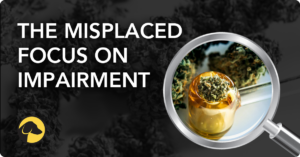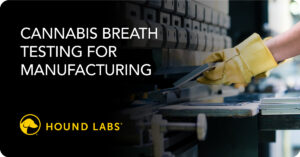
Effective Cannabis Testing: An MRO’s View
There is a growing demand for Medical Review Officer (MRO) services and the critical role an MRO can play in helping balance the needs of employers and employees during the era of cannabis legalization.
Recently, Angela Moore, CEO of Cynergy Wellness, Inc., a privately-owned and nationally recognized industry leader in the provision of MRO services, provided insight into why more businesses are turning to MROs to help navigate workforce drug testing.
That blog really resonated with our readers, so I reached out again, this time wanting to dive deeper into industry trends based on Angela’s expertise and experience.
Angela, thank you for talking with me about what makes workplace drug testing programs effective, Cynergy Wellness, Inc., and cannabis legalization.
What is the most misunderstood thing about drug testing?
Workplace drug testing was never intended to “catch” people; it is primarily about drug use deterrence and education. The goal of the Department of Transportation (DOT) testing program and the Occupational Safety and Health Administration (OSHA) is to ensure safe and healthy working conditions for workers and the public. This is a good framework to think about for all drug testing.
The reason employers test for alcohol, cannabis, and other drugs isn’t only because they are legal or illegal but because they can be dangerous. If an employee continuously tests positive for alcohol that’s a concern. Although it’s legal to use alcohol – and cannabis in many states – most employers do not want employees consuming them during the workday.
A secondary purpose of drug testing is to identify people who may need support. In these situations, it shouldn’t be viewed as punitive but rather as a point in time where you can identify a need and provide access to resources. For example, if an employee is using PCP or cocaine, that not only creates safety concerns but may also be a serious condition that needs attention. The opiate crisis put a spotlight on far too many individuals whose addiction started with a legally used substance. Workplace drug testing programs can provide an important safety net for those at risk or suffering from addiction.
What makes an employer drug testing program effective?
The best programs are the ones that have been well-advertised to employees. To achieve the goals of deterrence and education, employers who spend time educating their employees about why they have certain “drug-safe” policies will have the most impact. In the end, employees should know that effective drug testing programs keep them safe at work.
Workplace drug testing programs can also create a stronger sense of equity at work. Employees who struggle with substance use have higher absenteeism and reduced productivity. This can negatively impact their colleagues who must cover for them or deliver projects that absent colleagues are unable to complete. Often, it is the top performers (the ones who cover for their absent colleagues) who leave their companies due to frustration over this inequity.
In addition, effective programs are practical. They take into consideration that one size doesn’t fit all and include policies that are flexible and consistent – not all or nothing. Employers who have effective policies understand the end goal isn’t narrowly focused on pre-employment screening vs. impairment – because that’s an imperfect goal. Even with alcohol, signs of physical impairment vary from person to person. A blood alcohol content (BAC) of .05 means different things for different people. Although legally under the .08 limit, some people would be very impaired at that level and could not safely perform their job duties.
Measuring BAC is effective because it is a consistent way of measuring alcohol in the body, and that objective data is often combined with observations of behavioral and physical functions made by another person. Although a cannabis breathalyzer cannot be linked to a level of impairment, it can still be effective because it provides a consistent way of measuring THC (the psychoactive compound in marijuana) in breath with a detection window of a few hours. Objective data about recent cannabis use tied to the workday can be an effective deterrent. Some employers might combine the data with physical observations by managers or providers. Without objective data, employers must rely solely on subjective observations, and that creates its own set of problems.
Tell us a little bit about Cynergy Wellness, Inc. What makes your company unique?
Medical Review Officers help to balance the needs of the employer and the privacy of the employee. One of our roles is to act as the gatekeeper between the employer and the employee as it relates to accuracy in the testing process and to safeguard employees’ Protected Health Information (PHI). At Cynergy Wellness Inc., we work to ensure the fair, fast, and accurate handling of drug test results, safety-sensitive determinations, occupational health evaluations, infectious disease testing, and a wide range of consumer-oriented diagnostic testing services. Our certified MRO physicians, nurses, and a team of knowledgeable professionals and industry experts focus on the needs of employers, schools, government entities, and consumers to support comprehensive access to safety, health, and wellness.
Cannabis reform has caused a lot of employers to reevaluate many aspects of their drug testing programs. What are your thoughts on eliminating regular drug testing for cannabis?
We do not recommend eliminating all cannabis testing, even though most employees have legal access, and some employees may have medical referrals for cannabis use. Interestingly, we have observed in our business that roughly 70% of employees who claim to have medical cards for the therapeutic use of cannabis do not provide documentation to support the claim.
As MROs, our responsibility is to validate legitimate medical explanations for drugs detected – we do it for prescribed opioids and narcotics, and we validate medical referrals for the therapeutic use of cannabis. We talk with doctors to make sure they understand the type of job duties that are required of the employee with a prescription or referral. We also have conversations with the employee. We provide guidance to the employer regarding an employee’s ability to safely perform their job per their doctor’s recommendation. Remember, our primary goal is to keep employees, the workplace, and often the public, safe. By brokering these conversations, we mitigate risk, promote safety, and we maintain the privacy of the employee.
One way to approach cannabis testing is to think practically about what makes sense from a legal use and safety perspective. The first hurdle is legal use. From there, we understand that cannabis impairment typically last longer than a workday. So, employers will want to create a cannabis testing policy that restricts cannabis and limits detection to that practical timeframe – the workday. Focusing on a drug-safe workplace means incorporating testing policies and processes that not only deter unsafe behavior related to alcohol and drug use but are also fair.
Another important aspect of testing includes educating employees. Although cannabis may be legal to use, it can still be impairing – likewise with alcohol. Other legally prescribed therapeutic drugs can be impairing, as can over-the-counter medications. The use of any drug, in the wrong quantity, at the wrong time, or under the wrong circumstances, can be extremely dangerous. Employers play a key role in delivering quality education to their workforce, which can also be integrated into a comprehensive health strategy.
What do you believe are a few of the biggest unintended consequences of cannabis reform for employers and employees?
One unintended negative consequence of cannabis reform is the ambiguity surrounding how we define impairment. Determining impairment is an imperfect science for alcohol and drug detection. Most folks do not realize the widely adopted use of a ‘per se’ quantitative value for alcohol does not always correlate to what we would behaviorally recognize as impairment. That may seem counter-intuitive, but I will try to explain.
Alcohol breathalyzers determine whether alcohol was used recently and produce a quantitative value for its presence. In a typical employment setting, alcohol testing is performed as a secondary step when an individual demonstrates physical signs of use or impairment. Under the DOT guidelines for random testing, an employee testing positive for alcohol will have different consequences based on their quantitative level. They also have consequences if they were using immediately prior to or during work hours. The quantitative measure is only one of the tools. These policies have worked effectively because they are practical and enforceable for employers and fair for employees who can legally use substances outside of the workplace.
Workday cannabis use policies can be modeled similarly using a cannabis breath test with a detection window that correlates to recent use – well within a workday. Instead of eliminating cannabis testing entirely, employers can revisit their policies and clearly state what is permissible during the workday. Whether it’s random testing or testing that is invoked due to physical signs of impairment, the structure for executing these programs effectively has been in place for almost 30 years.
Angela, I really appreciate your perspectives and enjoyed our conversation.
For more insight from Angela on the role MROs can play, please check out this blog: The Growing Demand for Medical Review Officers. Cynergy Wellness, Inc. is part of the Hound Labs partner ecosystem. Learn more about the partnership here.

August 1, 2022
By JENNY LYNN
Co-Founder
Share












